This article was co-authored by George Sachs, PsyD. George Sachs is a Licensed Psychologist and the Owner of Sachs Center based in New York, New York. With over ten years of experience, Dr. Sachs specializes in treating ADD/ADHD and Autism Spectrum Disorders in children, teens, and adults. He holds a BS in Psychology from Emory University. Dr. Sachs earned his Doctorate of Psychology (PsyD) from the Illinois School of Professional Psychology, Chicago. He completed his clinical training in Chicago at Cook County Hospital, Mt. Sinai Hospital, and the Child Study Center. Dr. Sachs completed his internship and postdoctoral work at the Children’s Institute in Los Angeles, where he supervised and trained therapists in Trauma-Focused Cognitive Behavioral Therapy (TFCBT). He has been trained as a Gestalt Therapist and certified by the Gestalt Associates Training Program of Los Angeles. Dr. Sachs is the author of The Adult ADD Solution, Helping the Traumatized Child, and Helping Your Husband with Adult ADD. He has appeared on the Huffington Post, NBC Nightly News, CBS, and WPIX discussing his holistic approach to ADD/ADHD treatment.
There are 16 references cited in this article, which can be found at the bottom of the page.
wikiHow marks an article as reader-approved once it receives enough positive feedback. In this case, 100% of readers who voted found the article helpful, earning it our reader-approved status.
This article has been viewed 42,470 times.
Post-traumatic stress disorder, or PTSD, is a psychological condition that you might experience after enduring a dangerous or frightening ordeal. During the actual event, you might have gone into autopilot, or a "fight or flight" reaction, to survive the experience. However, with PTSD, the "fight or flight" response does not wane after the event; a person continues to feel the effects of the danger long after exposure. There are key signs to look for if you think you or a loved one may have PTSD.
Steps
Assessing Your Risk for PTSD
-
1Find out what PTSD is. Post-traumatic stress disorder (PTSD) is a mental illness that you can develop after going through a frightening and disturbing experience. After a traumatic situation, it is perfectly normal to feel a myriad of negative emotions such as confusion, sadness, aggravation, helplessness, sorrow and others – this is the regular psychological reaction that people go through when faced with a traumatic situation. However, those feelings should pass with time. With PTSD, those emotional responses get more severe rather than disappearing.[1]
- PTSD generally occurs when the event that you experience is frightening and life-threatening. The longer you are exposed to the trauma, the more likely you are to develop PTSD.
- Look for literature and resources to help you better understand PTSD.
-
2Don't deny symptoms of PTSD just because you weren't in the military. Since PTSD has long been associated with combat veterans, some people who have not been in war fail to identify their symptoms. If you have recently experienced a traumatic, frightening, or scarring experience, you might be suffering from post-traumatic stress disorder. Furthermore, PTSD doesn’t just happen to the actual victims of a life-threatening experience. Sometimes, if you only witnessed a terrifying event or had to deal with the aftermath, you may develop PTSD.[2]
- Common events that trigger PTSD include sexual assault, being threatened with a weapon, natural disasters, sudden loss of a loved one, car and airplane crashes, torture, combat, or witnessing a murder.
- It is important to note that most people who struggle with PTSD develop the disorder because of an act that was committed by another person, rather than a natural disaster.
Advertisement -
3Determine how long it has been since your stressful experience. As mentioned before, it is normal to have strong negative feelings after you go through something terrible. Within the first several weeks, this is called acute stress disorder. Nonetheless, after about a month passes, those negative feelings generally start to fade. PTSD becomes a concern when those feelings get stronger after more than a month has passed.[3]
-
4Be aware of the risk factors that can make you more prone to PTSD. PTSD is strange in that two people can go through the exact same experience, but one person develops PTSD while the other does not. There are some factors that can make you more likely to develop PTSD if you experience a traumatic event. It is important to remember that not everyone develops PTSD, even if these factors pertain to them. These factors include:[4]
- A history of psychological issues within your family. If you have relatives that suffer from anxiety or depression, you may have a higher risk of developing PTSD.
- The individualized way you respond to stress. Stress is normal, but some people have bodies that create larger amounts of chemicals and hormones that can cause abnormal reactions to stress.
- Other experiences you have had. If you have gone through other life traumas such as childhood abuse or neglect, this new trauma might only add to the horror you felt in the past, leading to PTSD.
Looking for Symptoms of PTSD
-
1Recognize feelings of avoidance. When you go through a traumatic experience, it might feel easier to avoid anything that reminds you of the incident; however, confronting the memories head-on is actually the healthiest way to deal with the trauma. If you have PTSD, you may go out of your way to avoid anything that reminds you of the ordeal that you went through. Symptoms of avoidance include:[5]
- Refusing to think about the situation.
- Staying away from people, places, or objects that remind you of the event.
- Not wanting to talk about the experience.
- Throwing yourself into a distraction, becoming obsessed with that activity rather than thinking about the event you experienced.
-
2Pay attention to intrusive memories you experience. Intrusive memories are memories that you can’t control--they suddenly pop into your head without you actually telling your brain to access those memories. You might feel helpless and unable to stop them. Types of intrusive memories include:[6]
- Vivid, out-of-the-blue flashbacks to the event.
- Nightmares that focus on what happened.
- A ‘slide show’ of images of the event that you can’t seem to stop from playing in your head.
-
3Take note if you find yourself wanting to deny that the event happened. Some people with PTSD react to a traumatizing event by denying that the event ever occurred. They might act completely normally, like their life has not been disturbed in any way. This is a form of shock and self-preservation; the mind shuts down the memory and understanding of what has happened to keep the body from pain.[7]
- For example, a mother may go into denial after the death of her baby son. She may continue to talk to him like he is sleeping, rather than accepting that he is gone.
-
4Monitor any changes in the way you think. People can have changes in opinion all the time. However, with PTSD, you will suddenly find yourself thinking about things--including people, places and things--in a way that you have never done before the traumatic incident. These changes in thought can include:[8]
- Negative thoughts about other people, places, situations and yourself.
- Indifference or a feeling of despair when thinking about the future.
- Inability to feel happiness or pleasure; feeling numb.
- Inability or severe difficulty to relate to others and maintain relationships.
- Memory problems ranging from forgetting small things to large memory gaps about the event.
-
5Recognize any emotional or physical changes you have experienced since the incident. Like with changes in thought, emotional and physical changes that you should take note of should be those that you never experienced before the event occurred. It is important to remember that these changes might happen every once in a while--it is more important to take note of them if they are constantly occurring. These changes can include[9] :
- Insomnia (which means an inability to sleep).
- Loss of appetite.
- Getting angered or irritated very easily and demonstrating aggression.
- Not being able to enjoy things that you found engaging before.
- Feeling overwhelmed by a strong sense of guilt or shame.
- Exhibiting self-destructive behaviors such as driving too fast, substance abuse, or making careless or risky decisions.
-
6Pay attention to any feelings of being on high alert. After a frightening and traumatizing event, you might find yourself feeling very nervous or jumpy. Things that normally wouldn’t scare you send you into a panic. A traumatizing event can cause your body to develop a heightened state of awareness that is not necessary, but feels necessary because of the trauma that you experienced.[10] [11]
- For example, if you experienced a bomb going off near you, you might find yourself jumping or panicking at the sound of someone dropping their keys or slamming a door.
-
7Talk to a mental health professional who has experience working with trauma victims. A psychologist or therapist will be able to help you determine whether or not what you are experiencing is a normal reaction to the event or if it is PTSD. Your health provider will help you determine which treatments may be best for your case. Treatment options for PTSD may include:[12] [13]
- Traditional talk therapy has shown effectiveness in helping treat either the symptoms of PTSD or helping sufferers cope with family, life or career problems that arise as a result of PTSD.
- Psychotherapy may be in the form of exposure therapy, which focuses on slowly talking about the traumatic event more and perhaps visiting places and/or people you have been avoiding, or stress inoculation training, which helps you to build healthy coping mechanisms to stressful or anxiety-provoking life events.
- A psychiatrist might prescribe you medications that may alleviate symptoms of depression, anxiety, or help to eliminate sleep disruptions.
Recognizing Conditions Connected to PTSD
-
1Look out for signs of depression. Living through a traumatizing experience can often cause people to feel depressed. If you think you have PTSD, you might also be experiencing depression. Look out for symptoms that include:[14] [15]
- Difficulty concentrating.
- Feelings of guilt, helplessness, and worthlessness.
- Decreased energy and a lack of interest in the things that normally make you happy.
- Feelings of deep sadness that won’t seem to go away; also experienced as feelings of emptiness.
-
2Monitor any feelings of anxiety that you experience. After a frightening or horrifying experience, you might develop anxiety. Anxiety goes beyond the normal feelings of stress or worry that people experience in their day to day lives. Signs of anxiety disorder may include:[16] [17]
- Constantly worrying or obsessing over small or large concerns or issues.
- Feeling restless or having no desire to relax.
- Being easily startled or feeling tense and twitchy.
- Trouble sleeping and a feeling that you can’t catch your breath.
-
3Pay attention to any Obsessive Compulsive (OCD) behaviors you may feel inclined towards. When you experience something that throws your whole world off-kilter, you generally strive to return to normal. However, some people go beyond this desire for normality by trying to overly control their environments. OCD can display itself in many ways, but if you are concerned you may have developed it, make sure to look for:[18]
- The desire to wash your hands constantly. You become paranoid that your skin is dirty or that you have somehow become contaminated.
- Obsessively checking to make sure things are in order. For example, checking ten times to make sure that the oven is turned off or the door is locked.
- A sudden obsession with symmetry. You find yourself counting things and arranging things to make sure that they are symmetrical and even.
- A refusal to throw anything away because you are afraid that something bad will happen if you do.
-
4Talk to someone if you are having hallucinations. Hallucinations are something you experience with one of your five senses that isn’t really happening. This can mean hearing voices that aren’t real, seeing things that aren’t really there, tasting or smelling phantom sensations, and experiencing the touch of something that isn’t actually touching you. Someone who is having these hallucinations will have a hard time distinguishing them from reality.[19]
- One way to figure out if you are hallucinating or not is to ask the people around you if they are experiencing the same thing.
- Be aware that these hallucinations may be a sign that you have an undiagnosed psychotic disorder like schizophrenia in addition to post-traumatic stress disorder. Researchers have found a high overlap between these two mental illness. It is really important to seek help as soon as you start seeing or hearing things that you are not sure really exist.
-
5Seek out a professional if you think that you might have amnesia. When you experience something traumatic, your body can actually shut that memory down in order to keep you from pain. You can also give yourself amnesia through repressing and denying that the incident actually occurred. If you suddenly feel like you are hazy about the details of your life or feel like you’ve lost time without knowing where it went, you should talk to a therapist or someone you trust.[20]
Expert Q&A
-
QuestionWhat should I do after I get diagnosed with PTSD?
 George Sachs, PsyDGeorge Sachs is a Licensed Psychologist and the Owner of Sachs Center based in New York, New York. With over ten years of experience, Dr. Sachs specializes in treating ADD/ADHD and Autism Spectrum Disorders in children, teens, and adults. He holds a BS in Psychology from Emory University. Dr. Sachs earned his Doctorate of Psychology (PsyD) from the Illinois School of Professional Psychology, Chicago. He completed his clinical training in Chicago at Cook County Hospital, Mt. Sinai Hospital, and the Child Study Center. Dr. Sachs completed his internship and postdoctoral work at the Children’s Institute in Los Angeles, where he supervised and trained therapists in Trauma-Focused Cognitive Behavioral Therapy (TFCBT). He has been trained as a Gestalt Therapist and certified by the Gestalt Associates Training Program of Los Angeles. Dr. Sachs is the author of The Adult ADD Solution, Helping the Traumatized Child, and Helping Your Husband with Adult ADD. He has appeared on the Huffington Post, NBC Nightly News, CBS, and WPIX discussing his holistic approach to ADD/ADHD treatment.
George Sachs, PsyDGeorge Sachs is a Licensed Psychologist and the Owner of Sachs Center based in New York, New York. With over ten years of experience, Dr. Sachs specializes in treating ADD/ADHD and Autism Spectrum Disorders in children, teens, and adults. He holds a BS in Psychology from Emory University. Dr. Sachs earned his Doctorate of Psychology (PsyD) from the Illinois School of Professional Psychology, Chicago. He completed his clinical training in Chicago at Cook County Hospital, Mt. Sinai Hospital, and the Child Study Center. Dr. Sachs completed his internship and postdoctoral work at the Children’s Institute in Los Angeles, where he supervised and trained therapists in Trauma-Focused Cognitive Behavioral Therapy (TFCBT). He has been trained as a Gestalt Therapist and certified by the Gestalt Associates Training Program of Los Angeles. Dr. Sachs is the author of The Adult ADD Solution, Helping the Traumatized Child, and Helping Your Husband with Adult ADD. He has appeared on the Huffington Post, NBC Nightly News, CBS, and WPIX discussing his holistic approach to ADD/ADHD treatment.
Licensed Psychologist If you've received a diagnosis, the first step is to find a therapist who you really like and can work with. Research shows if you like your therapist, you're going to get better. You really need to feel comfortable and safe with your therapist.
If you've received a diagnosis, the first step is to find a therapist who you really like and can work with. Research shows if you like your therapist, you're going to get better. You really need to feel comfortable and safe with your therapist. -
QuestionHow is PTSD treated?
 George Sachs, PsyDGeorge Sachs is a Licensed Psychologist and the Owner of Sachs Center based in New York, New York. With over ten years of experience, Dr. Sachs specializes in treating ADD/ADHD and Autism Spectrum Disorders in children, teens, and adults. He holds a BS in Psychology from Emory University. Dr. Sachs earned his Doctorate of Psychology (PsyD) from the Illinois School of Professional Psychology, Chicago. He completed his clinical training in Chicago at Cook County Hospital, Mt. Sinai Hospital, and the Child Study Center. Dr. Sachs completed his internship and postdoctoral work at the Children’s Institute in Los Angeles, where he supervised and trained therapists in Trauma-Focused Cognitive Behavioral Therapy (TFCBT). He has been trained as a Gestalt Therapist and certified by the Gestalt Associates Training Program of Los Angeles. Dr. Sachs is the author of The Adult ADD Solution, Helping the Traumatized Child, and Helping Your Husband with Adult ADD. He has appeared on the Huffington Post, NBC Nightly News, CBS, and WPIX discussing his holistic approach to ADD/ADHD treatment.
George Sachs, PsyDGeorge Sachs is a Licensed Psychologist and the Owner of Sachs Center based in New York, New York. With over ten years of experience, Dr. Sachs specializes in treating ADD/ADHD and Autism Spectrum Disorders in children, teens, and adults. He holds a BS in Psychology from Emory University. Dr. Sachs earned his Doctorate of Psychology (PsyD) from the Illinois School of Professional Psychology, Chicago. He completed his clinical training in Chicago at Cook County Hospital, Mt. Sinai Hospital, and the Child Study Center. Dr. Sachs completed his internship and postdoctoral work at the Children’s Institute in Los Angeles, where he supervised and trained therapists in Trauma-Focused Cognitive Behavioral Therapy (TFCBT). He has been trained as a Gestalt Therapist and certified by the Gestalt Associates Training Program of Los Angeles. Dr. Sachs is the author of The Adult ADD Solution, Helping the Traumatized Child, and Helping Your Husband with Adult ADD. He has appeared on the Huffington Post, NBC Nightly News, CBS, and WPIX discussing his holistic approach to ADD/ADHD treatment.
Licensed Psychologist If you have PTSD, treatment would involve working with a therapist to unpack the trauma and expose yourself to the trauma in the safety of the therapist's office over time. When you reexpose yourself to the trauma and tell your story to the therapist over and over, your body doesn't react to it in the same way because it becomes boring. And that's the goal. Most of the time, we hide and don't share our trauma. And it just lives in our bodies and our minds. When you share your trauma in the safe space of a therapist's office, you're kind of cleansing yourself of it. Also, the therapist will teach you different ways to manage the anxiety and trauma episodes with cognitive behavioral therapy and meditation and mindfulness.
If you have PTSD, treatment would involve working with a therapist to unpack the trauma and expose yourself to the trauma in the safety of the therapist's office over time. When you reexpose yourself to the trauma and tell your story to the therapist over and over, your body doesn't react to it in the same way because it becomes boring. And that's the goal. Most of the time, we hide and don't share our trauma. And it just lives in our bodies and our minds. When you share your trauma in the safe space of a therapist's office, you're kind of cleansing yourself of it. Also, the therapist will teach you different ways to manage the anxiety and trauma episodes with cognitive behavioral therapy and meditation and mindfulness.
Warnings
- If you think you may have PTSD, seek out a therapist right away.⧼thumbs_response⧽
- Do not attempt or threaten to hurt/kill others or yourself.⧼thumbs_response⧽
- Don’t bring weapons to school or work. You could get in serious trouble such as expulsion or being arrested.⧼thumbs_response⧽
- Don’t drink too much alcohol. This will only make things worse.⧼thumbs_response⧽
References
- ↑ https://psychiatry.org/patients-families/ptsd/what-is-ptsd
- ↑ https://psychcentral.com/blog/denial-of-trauma-signs
- ↑ https://www.nimh.nih.gov/health/topics/post-traumatic-stress-disorder-ptsd
- ↑ https://www.nimh.nih.gov/health/topics/post-traumatic-stress-disorder-ptsd/index.shtml#part_145372
- ↑ https://www.helpguide.org/articles/ptsd-trauma/ptsd-symptoms-self-help-treatment.htm
- ↑ https://pubmed.ncbi.nlm.nih.gov/26257660/
- ↑ http://psychcentral.com/lib/symptoms-and-diagnosis-of-ptsd/000158
- ↑ https://adaa.org/understanding-anxiety/posttraumatic-stress-disorder-ptsd/symptoms
- ↑ https://www.apa.org/topics/trauma/stress
- ↑ https://www.helpguide.org/articles/ptsd-trauma/ptsd-symptoms-self-help-treatment.htm
- ↑ George Sachs, PsyD. Licensed Psychologist. Expert Interview. 5 March 2021.
- ↑ http://www.nimh.nih.gov/health/publications/post-traumatic-stress-disorder-ptsd/index.shtml
- ↑ George Sachs, PsyD. Licensed Psychologist. Expert Interview. 5 March 2021.
- ↑ https://www.helpguide.org/articles/depression/depression-symptoms-and-warning-signs.htm
- ↑ George Sachs, PsyD. Licensed Psychologist. Expert Interview. 5 March 2021.
- ↑ George Sachs, PsyD. Licensed Psychologist. Expert Interview. 5 March 2021.
- ↑ https://www.hhs.gov/answers/mental-health-and-substance-abuse/what-are-the-five-major-types-of-anxiety-disorders/index.html
- ↑ https://www.helpguide.org/articles/anxiety/obssessive-compulsive-disorder-ocd.htm
- ↑ https://medlineplus.gov/ency/article/003258.htm
- ↑ https://my.clevelandclinic.org/health/diseases/9789-dissociative-amnesia
About This Article
If you think you might have PTSD after having a traumatic experience, pay attention to intrusive memories or flashbacks that you can’t control, as well as feelings of avoidance. If you have PTSD, you might stay away from people or places that remind you of the event or even deny that the event happened. Additionally, because trauma can cause your body to be in a heightened state of awareness, you might feel nervous or jumpy in response to things that usually wouldn’t bother you. Pay attention to general feelings of hopelessness or apathy, difficulty maintaining close relationships, and memory loss surrounding the time of the trauma. If you are experiencing any of these symptoms, know that you are not alone and there are people who can help you. Talk to a mental health professional who specializes in working with trauma victims. Your treatment options might include traditional talk therapy or exposure therapy, as well as medications that may alleviate symptoms of depression and anxiety associated with PTSD. For more advice from our Mental Health co-author, like how to recognize other conditions connected to PTSD, keep reading!
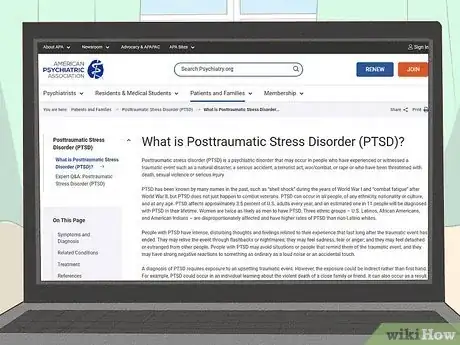
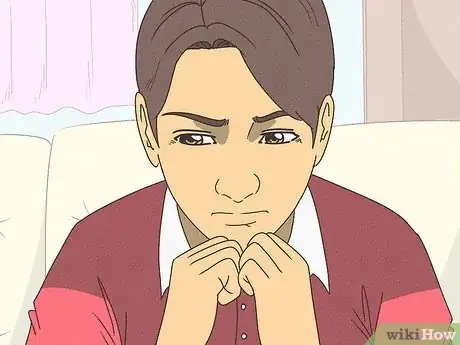
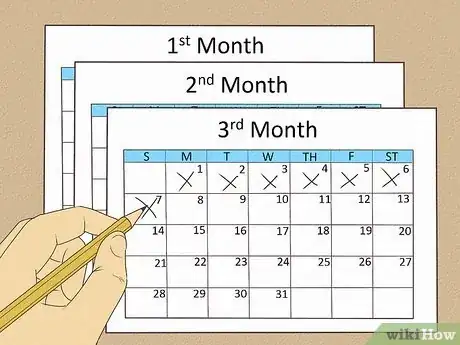
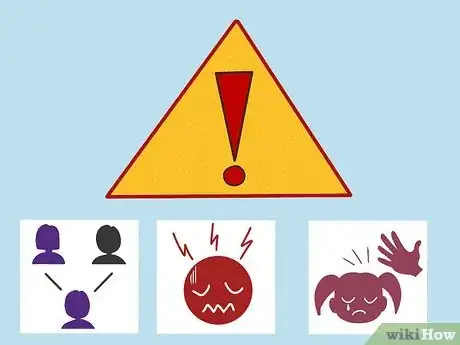

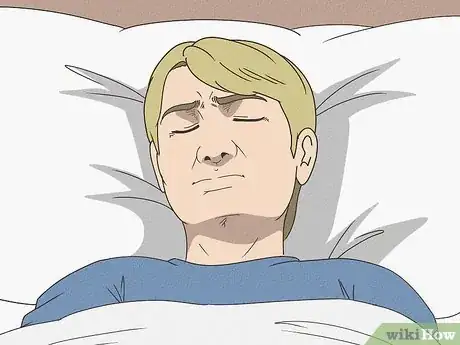
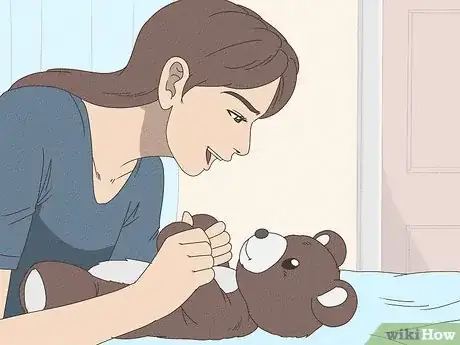
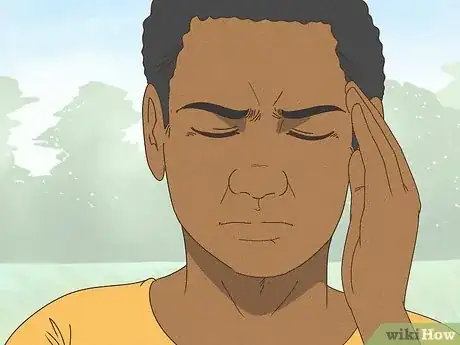

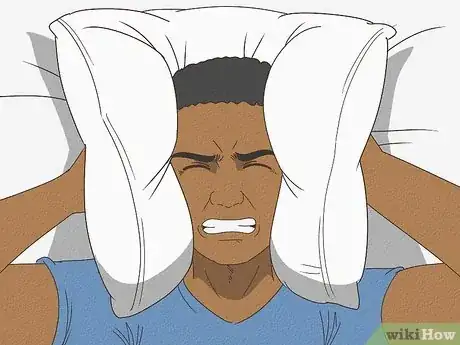







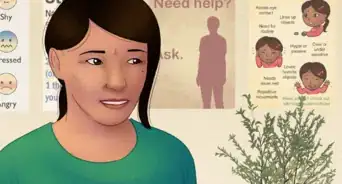

-Step-13.webp)


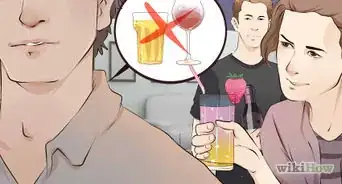










-Step-13.webp)




































Medical Disclaimer
The content of this article is not intended to be a substitute for professional medical advice, examination, diagnosis, or treatment. You should always contact your doctor or other qualified healthcare professional before starting, changing, or stopping any kind of health treatment.
Read More...